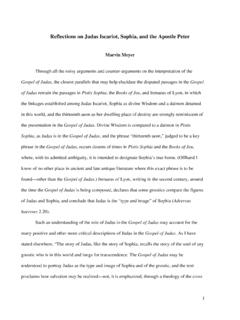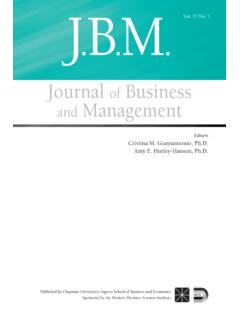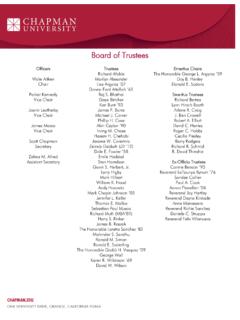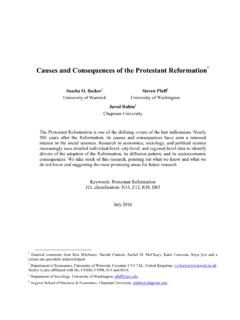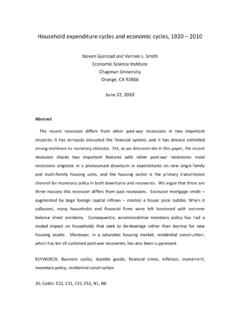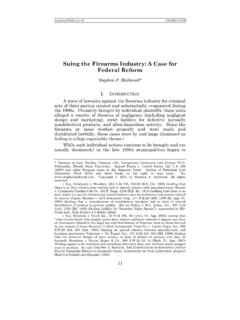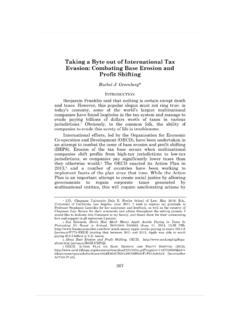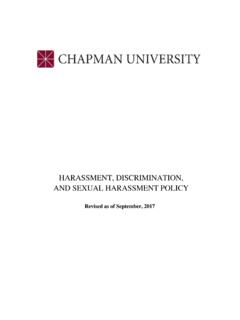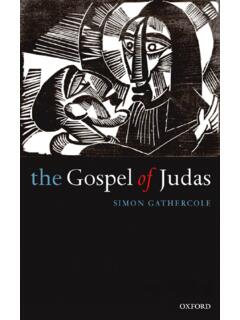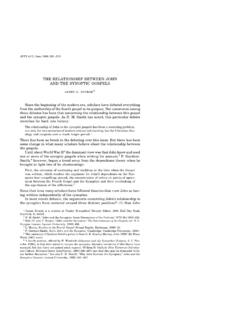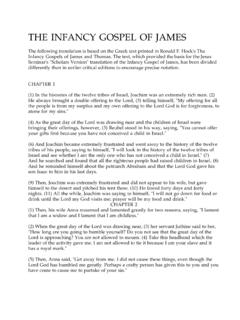Transcription of The Gospels of Judas, Mary, and Thomas: The …
1 1 The Gospels of judas , Mary, and Thomas: The rehabilitation of marginalized disciples in Early Christian Literature Lecture presented in Tokyo and Brussels Marvin Meyer Doubting Thomas, Mary Magdalene, judas Iscariot: the very names of these disciples conjure up images in Christian tradition of bad faith, questionable morality, and wicked betrayal. In the New Testament Gospels , to be sure, all the disciples have moments of doubt and uncertainty, and Peter himself denies vehemently and profanely that he knows Jesus on the eve of the crucifixion. Yet within the New Testament and early church history, Thomas, Mary, and judas are shunned and ostracized in particular ways and for particular reasons.
2 In the Gospel of John, Thomas is doubting Thomas, the stubborn disciple who will not believe until he touches the wounds of the crucified and raised Jesus. According to the Gospel of Luke chapter 8, Mary Magdalene has to be cleansed by Jesus of demon possession (she is a woman, it is suggested, with psychological or social problems), and in the late sixth century Pope Gregory the Great equated her (wrongly) with the unnamed prostitute of Luke 7, so that thereafter Mary Magdalene is thought to be a repentant whore repentant, but a whore nonetheless. It is no wonder that she cannot break into the circle of the Twelve in most of Christian tradition. And judas Iscariot remains one of the most vilified of all the characters in human history.
3 Didn t he turn his friend, perhaps his best friend, over to the Roman authorities 2 to be crucified? Didn t he do so with a kiss the judas kiss? Is there anything more heinous and reprehensible than that? Hence, Thomas, Mary Magdalene, and judas Iscariot have commonly been marginalized as followers of Jesus at least until recent times. In the past century or so, several early Christian Gospels have been discovered in the sands of Egypt, and these newly recovered texts have begun to shed important new light on the early church and the roles of disciples of Jesus in early Christian communities. According to these Gospels , Thomas, Mary Magdalene, and judas Iscariot may be viewed in a much more positive way than traditionally has been the case.
4 Thomas may be understood as the guarantor of the sayings of Jesus, Mary may be a beloved disciple, and judas may have been the one who knew Jesus best and followed him with the greatest loyalty. The Gospels of Thomas, Mary, and judas have all come to the attention of scholars and other interested readers in the past few years, and since their discovery they have suggested exciting new possibilities for how we may choose to read and interpret the history of the Christian movement, from the earliest days until the present. * * * * * Around the end of 1945, the texts known as the Nag Hammadi library were discovered, not at the city of Nag Hammadi itself, but near the base of a majestic cliff, the Jabal al-Tarif, which flanks the Nile River a few kilometers from Nag Hammadi.
5 Among the texts in the Nag Hammadi library was a Coptic translation of the Gospel of Thomas, an early Christian gospel known from a few citations in the church fathers and, as it turns out, Greek papyrus fragments 3 uncovered in an ancient rubbish heap at Oxyrhynchus in Egypt. The villages closest to the Jabal al-Tarif bear the names Hamra Dum, al-Busa, al-Dabba (the site of the Monastery of the Angel, Deir al-Malak), al-Qasr (the site of the Pachomian monastery at Chenoboskion), and Faw Qibli (the site of the Pachomian monastery at Pbow). Five years after the discovery, the French scholar Jean Doresse explored the region and tried to find out the circumstances of the discovery of the Nag Hammadi library.
6 He published his story in his book, The Discovery of the Nag Hammadi Texts. According to Doresse, he spoke with some people from the area, and they directed him to the southern part of an ancient cemetery. They reported that peasants from Hamra Dum and al-Dabba, searching for natural fertilizer (manure), found somewhere near this locale a large jar filled with papyri bound in the form of books. Doresse writes, The vase was broken and nothing remains of it; the manuscripts were taken to Cairo and no one knows what then became of them. As to the exact location of the find, opinion differed by some few dozen yards; but everyone was sure that it was just about here. And from the ground itself we shall learn nothing more; it yields nothing but broken bones, fragments of cloth without interest, and some potsherds.
7 He concludes, We have never been able to discover exactly where the Coptic Manichaean manuscripts came from, nor the Pistis Sophia, nor the Bruce Codex. So it was well worth the trouble to find out, in a pagan cemetery a few miles from Chenoboskion, the exact site of one of the most voluminous finds of ancient literature; thus to be a little better able to place 4 this library in the frame of history to which it belongs; and to support, with concordant details, the hypotheses that have been made about its antiquity. James M. Robinson has offered another version of the story of the discovery. For a number of years, Robinson conducted interviews with people from the towns and villages in the Nag Hammadi area, in particular Muhammad Ali of the al-Samman clan, a resident of al-Qasr, and from the interviews he pieced together a fascinating account of how the Nag Hammadi codices were uncovered.
8 Where possible, Robinson attempted to confirm dates and events from official records. As Robinson has reconstructed the story, the discovery of the Nag Hammadi library took place in about December of 1945, when several Egyptian fellahin, including Muhammad Ali, his brothers Khalifah Ali and Abu al-Magd, and others, were riding their camels to the Jabal al-Tarif in order to gather sabakh, a natural fertilizer that typically accumulates around there. They hobbled their camels at the foot of the Jabal, the account continues, and began to dig around a large boulder on the talus, or slope of debris, that has formed against the cliff face. As they were digging, they unexpectedly came upon a large storage jar buried by the boulder, with a bowl sealed on the mouth of the jar as a lid.
9 Apparently the youngest of the brothers, Abu al-Magd, initially uncovered the jar, but Muhammad Ali, as the oldest of the brothers, took control of the operation. In his account of what transpired, Muhammad Ali has suggested to Robinson that he paused before removing the lid or breaking open the jar, out of fear that the jar might contain a jinni, or spirit, that could cause trouble if released from the jar. It seems that Muhammad Ali also recalled stories of hidden treasures buried in Egypt, and his love of gold overcame his fear of jinn. He smashed the jar with his mattock, and indeed something golden in color and glistening in the sunlight 5 fragments of papyrus, we might conclude flew out of the jar and disappeared into the air.
10 And when he looked into the broken jar to see what remained, he found only a collection of old books the codices of the Nag Hammadi library. Robinson s version of the story is carefully documented, and it includes colorful anecdotes and detailed accounts of events. For instance, Robinson reminisces about how he persuaded Muhammad Ali to return to the site of the discovery, so close to Hamra Dum, where a family caught up in acts of vengeance with the family of Muhammad Ali lived. Robinson recalls, I had to go to Hamra Dum myself, find the son of Ahmad Isma il, the man Muhammad Ali had butchered, and get his assurance that, since he had long since shot up a funeral cort ge of Muhammad Ali s family, wounding Muhammad Ali and killing a number of his clan, he considered the score settled.
